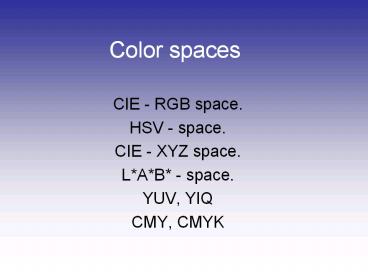Color spaces - PowerPoint PPT Presentation
Title:
Color spaces
Description:
CIE-XYZ Gamut Considerations in determining the R,B,G primitives Color segmentation Color segmentation ... The number of colors in the original image 80,000, ... – PowerPoint PPT presentation
Number of Views:862
Avg rating:3.0/5.0
Title: Color spaces
1
Color spaces
- CIE - RGB space.
- HSV - space.
- CIE - XYZ space.
- LAB - space.
- YUV, YIQ
- CMY, CMYK
2
CIE-XYZ Gamut
- Only the area between R,G,B can be reproduced by
R,G,B primaries.
3
Considerations in determining the R,B,G primitives
- Producing a wide range of colors
- Dynamic range considerations dont use colors
that you dont need. - System considerations Colors that are easy to
produce by color monitors.
4
cian paint
The CMY(K) model
5
Perceptual Models
- Lab color space normalizes the color space such
that Euclidian distances will fit the perceptual
ones (using JND) - For example Human vision has a nonlinear
perceptual response to brightness. - In general, ?I needed for just noticeable
difference (JND) over background I was found to
satisfy ?I /I const - Webers low lightness perception is roughly
logarithmic. - This is comparable to the L component of the
perceptual Lab color model
6
Color segmentation
First try ? Segment the image according to its
color histogram- Find Clusters of colors in the
RGB space (or make a color quantization)
Problem In the RGB space, there is information
which is not relevance to the chromaticity
lightening, texture and shadows. We need to
eliminate the intensity !
7
Color segmentation (cont)
Solution Convert the RGB image to another image
space containing an intensity component- omit
this component from the segmentation process.
Examples YIQ Omit Y HSV (Hue, Saturation,
Value) Omit V
Color segmentation using the HSV model
Original image
8
Skin Color
Task We would like to detect faces according to
their color histograms
Skin Color The chromaticity of skin is very
restricted (mainly the Hue component
) Skin Color is due to the amount of the
pigment melanin
9
Skin Color (cont)
Hue
Saturation
Value
10
White balancing
Problem The color image is effected by the color
of the light. Example Outdoor scenes are more
blue than indoor scenes.
Possible solution (far from perfect) Perform
white balancing find white regions, and
change the color map such that these regions
will become real white. Sometime, color skin can
also be used for this purpose.
11
Simplified Physical Model
- An image is a function of many parameters
12
Simplified Physical Model
- It is common to divide it into Lambertian
components and specular ones. - Lambertian The light is returned to all
direction. - Specular The light is returned in approx one
direction. - Most objects are mainly Lambertian, but have a
small Specular component.
13
Simplified Physical Model
- For Lambertian objects, the specular component is
zero therefore we have a linear function. - Pixels belonging to a region with homogenous
color should lie upon a line throw the origin in
the RGB histogram. - With the Specular component, these pixels will
lie on a plane (but most of the pixels will still
lie on the original line)
14
The T-Shape model.
- The T shape model introduced by Klinker et al. is
widely used to model specularity. - The model assumes a large n in the previous
equation gt for each pixel there is only one
dominant component
15
The color line model An ongoing work of Ido Omer
and Mike Werman.
16
Real Histogram properties.
- The lines best describing the color clusters
dont intersect the origin.
17
Cut Off
- One of the possible causes for the inaccuracy of
the linear model is the cut off phenomena in
image sensors.
18
Looking at the histogram
19
Looking at the histogram
20
Looking at the histogram
21
Looking at the histogram
22
Comparing color segmentation using different
color models.
Original
Lab
HSV
Color Lines
23
Color segmentation with color lines
- slice the histogram perpendicularly to the
origin. - search for local maxima.
- combine these maxima to color lines
24
Color segmentation with color lines
- Since we look only at the histogram, we are not
effected by local image properties like texture. - The number of colors in the original image gt
80,000, yet it has been described using 40
lines. - Conclusion The color histograms of natural
images are very sparse.
25
Other distortions
Be aware Most cameras apply various color
enhancements that distorts the linear color model.
26
Talking about mosaicing, the opposite problem
also exists.
- Most digital cameras use filter arrays to sample
red, green, and blue according to the Bayer
pattern or similar ones. - At each pixel only one color sample is taken, and
the values of the other colors must be
interpolated from neighboring samples.
27
Demosaicing.
- Many demosaicing techniques refer to the green
channel as the detail channel and to the
red/blue channels as chrominance channels. - These techniques start by interpolating green
values and then interpolate red/blue values
according to the green one.































